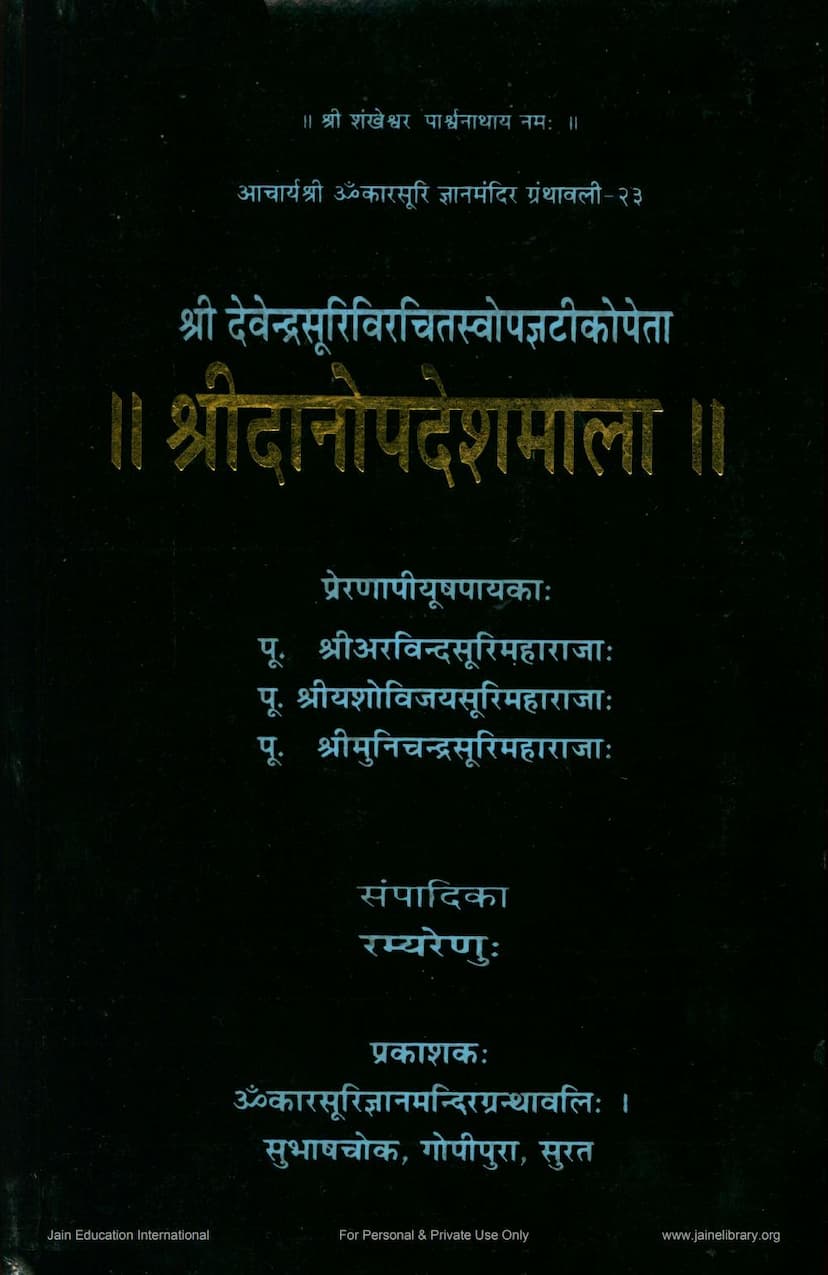Danopdeshmala
Added to library: September 1, 2025

Summary
This document is the Shri Danopadeshmaala (श्रीदानोपदेशमाला), a Jain text authored by Acharya Shri Devendrasuri and commented upon by his own interpretation (Swopagya Teekopeta). The book is presented as the 23rd volume in the Acharya Shri Omkarsuri Gyanmandir Granthavali series.
Here's a comprehensive summary based on the provided pages:
Core Subject: The book is primarily about Dana (दान), the practice of giving or charity in Jainism, which is considered a fundamental pillar of religious practice and a path to spiritual merit and liberation.
Key Aspects Highlighted:
- Author and Commentary: The original text is by Acharya Shri Devendrasuri. The presence of his "Swopagya Teeka" (स्वोपज्ञटीका), meaning his self-authored commentary, indicates a deep and authoritative exposition of the topic.
- Inspirational Figures: The publication is dedicated to and inspired by several revered Jain monks (Acharyas), including Pujya Shri Arvind Suri Maharaj, Pujya Shri Yashovijay Suri Maharaj, and Pujya Shri Muni Chandra Suri Maharaj.
- Editorial and Publishing: The text is compiled and edited by RamyaRenu (रम्यरेणुः). It is published by Omkarsuri Gyanmandir Granthavali in Surat. The publication also acknowledges the financial support of Shri Vardhaman Jain Sangh, Katargam Darwaza, Surat.
- Significance of Dana: The text strongly emphasizes the importance and multifaceted benefits of Dana. It is described as the first step towards religious practice and a means to achieve liberation (Moksha).
- Types of Dana: The book likely categorizes and explains different types of Dana, such as:
- Supatra Dan (सुपात्रदान): Giving to worthy recipients (like monks and nuns).
- Uchit Dan (उचितदान): Appropriate or suitable giving.
- Anukampa Dan (अनुकंपादान): Giving out of compassion.
- Abhaya Dan (अभयदान): Giving fearlessness or protection.
- Gyan Dan (ज्ञानदान): Giving knowledge.
- Illustrative Stories (Katha): A significant portion of the text appears to consist of various stories (kathas) that illustrate the principles and benefits of Dana. The summaries mention numerous such examples, including:
- Shri Yugadi Dev Charitra (श्रीयुगादिदेवचरित्र): Tales related to the first Tirthankara, Rishabhadeva, showcasing acts of giving.
- Shri Bharat Chakri Katha (श्रीभरतचक्रिकथा): Stories about Emperor Bharat, the son of Rishabhadeva, highlighting his extensive acts of charity.
- Shri Chandanbala Charitra (श्रीचंदनबालाचरित्र): The story of Chandanbala, a devoted disciple known for her exemplary charity.
- Shri Vajraswami Drushtant (श्रीवज्रस्वामिदृष्टान्त): An example related to Vajraswami, a revered monk.
- Shri Dhananand (Dhan Sen) Shreshti Katha (श्रीधननंद (धनसेन) श्रेष्ठिकथा): Stories about the merchant Dhananand (or Dhan Sen), illustrating principles of giving.
- Shri Megharath Chakravarti (श्रीमेघरथचक्रवर्ती): An example of righteous giving from King Megharatha.
- Shri Mṛganka (श्रीमृगाङ्क): A story related to the practice of giving clothes.
- Shri Avanti Sukumal (श्रीअवन्तिसुकुमाल): A narrative about giving shelter or residence.
- Shri Durgat Naigam (श्रीदुर्गतनैगम): An example related to giving blessings or respect.
- Shri Mṛga (श्री मृग): A story illustrating the importance of giving service.
- Shri Nidhi Dev & Bhog Dev (श्रीनिधिवेदोगदेव): Stories demonstrating the impact of giving with or without satisfaction.
- Shri Mammaṇ Shreshti (श्री मम्मण श्रेष्ठि): An example of someone who didn't give.
- Vaidya Sut (वैद्यसुत): A story about giving medicine.
- Shri Amar Sen & Var Sen (श्रीअमरसेन-वरसेन): Narratives illustrating the fruits of good deeds and charity.
- Purpose of Dana: The text emphasizes that Dana leads to merit (Punya Bandha), purification of the soul, and ultimately contributes to spiritual progress and liberation.
- Qualities of a Donor and Recipient: The book likely elaborates on the qualities that make a donor virtuous and a recipient worthy, stressing the importance of intent (Bhava) and the purity of the act.
- Linguistic Style: The text is written in Prakrit and Gujarati (based on the title and some page descriptions). The language in the stories is described as simple, attractive, and flowing.
- Compilation and Editing: The publication process involved meticulous research, comparing various handwritten manuscripts to compile the most accurate version. The editorial work included not only text collation but also providing meanings for difficult words and completing incomplete passages.
- Historical and Scholarly Context: The introduction and editorial notes provide context about the author, his lineage (Rudpallya Gachha), the historical period of the gachha, and the challenges in finding and publishing this specific, previously unpublished work.
- Structure: The book appears to be well-structured, with a detailed index (Vishay Soochi - विषयः) outlining the topics covered by each story.
In essence, the Shri Danopadeshmaala is a profound Jain scripture that meticulously explores the virtue of charity through philosophical discourse, scriptural references, and a rich collection of illustrative stories, aiming to guide readers towards spiritual upliftment and ultimate liberation through the practice of giving.